Fashioning the Sublime: Alexander McQueen at the Metropolitan Museum of Art
CONTRIBUTOR’S NOTE: This week marks the final chance to see Savage Beauty before it closes on Sunday, August 7th. Due to the exhibit’s overwhelming popularity, the Metropolitan Museum has scheduled special viewing times for the upcoming weekend. Do not miss the opportunity to witness this one-of-a-kind show honoring one of the most spectacular talents to ever grace the fashion world.
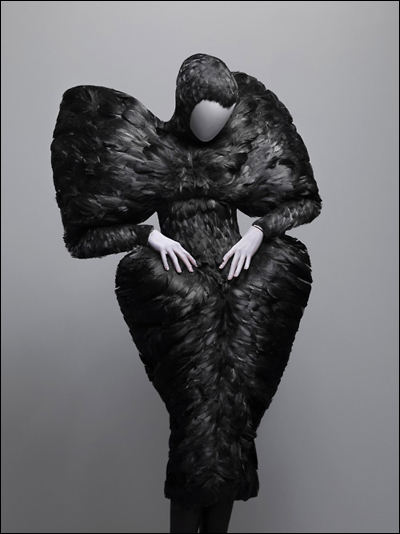
Alexander McQueen’s “The Horn of Plenty”, autumn/winter 2009-10. Black duck feathers. (via)
“When I am dead and gone, people will know that the twenty-first century was started by Alexander McQueen.” -Alexander McQueen (1969-2010)
The death of the Scottish designer Lee Alexander McQueen in February of 2010 sent shockwaves throughout the fashion industry that rippled steadily outward, pervading the worlds of fine art, music, theatre and design. Suddenly, one of the bravest, boldest and incredibly imaginative forces in fashion was gone. McQueen’s suicide took place just a week after his beloved mother, Joyce, died from cancer, and with little more than a month to go before he was to debut a new collection in Paris. The international outpouring of grief was palpable, as everyone, from socialites, celebrities and fashion students from countless walks of life remembered the designer in extensive magazine features, blog posts, Twitter updates, and Tumblr tributes. McQueen’s strong features and piercing stare appeared on the cover of most major newspapers.
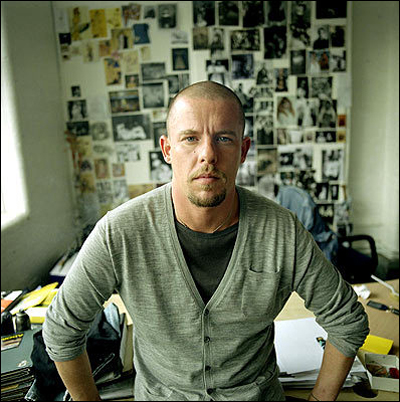
(via)
McQueen’s influence was undeniable; he had unleashed, with collection after collection, a romantic assault on the senses and invited his viewers to look with their minds, not merely their bodies, when deciding what to wear and how to wear it.
Never had a designer injected so much personal anguish and cerebral delight in his creations, and the materials he used, from pony skin, ostrich feathers, medical slides, hammered silver, balsa wood and tulle, became fashioning for the soul. For the past several months, devotees have streamed through the Metropolitan Museum of Art in New York City to personally experience many of his most iconic creations up close, presented in the Alexander McQueen: Savage Beauty retrospective. Curated by Andrew Bolton of The Costume Institute, the exhibit shows more than one hundred designs in tailor-made galleries befitting each of McQueen’s influences.
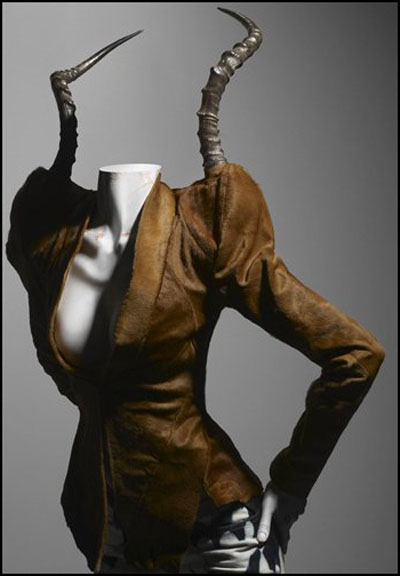
Ensemble from It’s a Jungle Out There, autumn/winter 1997–98. Jacket of brown pony skin and impala horns; trousers of bleached denim.
In the words of Bolton, “[McQueen’s] fashions were an outlet for his emotions, an expression of the deepest, often darkest, aspects of his imagination. He was a true Romantic in the Byronic sense of the word – he channeled the sublime.” The journey from his tailoring apprenticeship on Savile Row to his post-graduate collection at Central St. Martins (entitled ‘Jack the Ripper Stalks His Victims” and bought in its entirety by the late, great fashion stylist, Isabella Blow) to five years at Givenchy to a label of his own backed by the Gucci Group, saw Alexander McQueen become one of the most celebrated and notorious talents of his generation.
McQueen’s spring/summer runway show, 1999, featuring Shalom Harlow in one of the most memorable runway spectacles of all time. (via)
Not merely a tailor or couturier, McQueen long reigned as the enfante-terrible of fashion– a cheeky baby-faced Brit who delighted in pomp and spectacle with a dash of the naughty and macabre. Here was the man who attached gazelle horns to jacket shoulders, made dresses using ripped lace, real flowers, dung beetles and dead birds, commissioned hats of cork carved into Japanese gardens, fashioned silver corsets to look like curling spines, forced his models into ten-inch ‘armadillo’ stilettos and subjected Shalom Harlow and all her mock-horror to be spray painted by robots while on a revolving turn-table.

Alexander McQueen sleeveless evening dress from ‘Voss,’ spring 2001. Red feathers and glass microscope slides.
Nothing –from famine to amputation to the Gothic and the Byronic– was off-limits to McQueen. His mind was a constantly turning Rolodex of lush imagery and sadistic reality, taking quotes from the pages of history, and materials from the natural world surrounding him. “I’m inspired by a feather, its graphics, its weightlessness, and its engineering,” McQueen had said regarding his many designs indebted to the plumage of turkey, duck and ostrich. This fixation is seen in many of his creations, from a dress made from black and red ostrich feathers and medical slides, to the engrossing ‘Horn of Plenty,’ a hooded dress with exaggerated shoulders and hips made entirely of black duck feathers, to the multi-tiered gown from the Widows of Culloden collection based on the silhouette of the 1890s and covered with pheasant feathers. Women become flights of fancy and birds of prey in McQueen’s world, silently stalking the viewer, a victim waiting to be devoured, before retreating to their perches on the catwalk or in this case, behind glass.
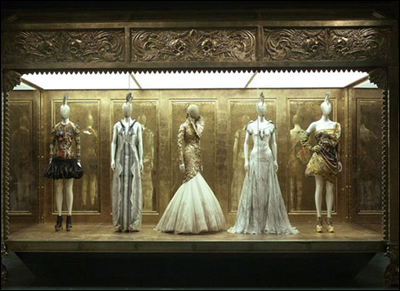
Display case from Savage Beauty at The Metropolitan Museum of Art, 2011. (via)
The entrance line for Savage Beauty ropes visitors into a melee of after-work crowds and hordes of tourists surrounded by masterworks of 19th century painting, their themes of escape and abandon all-too-perfect for McQueen. Viewers are instructed by guards to keep the line moving, and told that no cell phones or photographs of any kind will be allowed while inside the exhibit. This rule is promptly broken by many who enter the dark grey foyer to be greeted by that aforementioned, irresistibly photogenic ensemble of ostrich feathers and medical slides, as well a dress made entirely of stripped clam shells. As camera phones flash and iPhones buzz with life, there seems to be an unspoken rule; leave your inhibitions behind the rope; you are in McQueen’s territory now. From that first glimpse of the feathers, it is unthinkable to turn back.
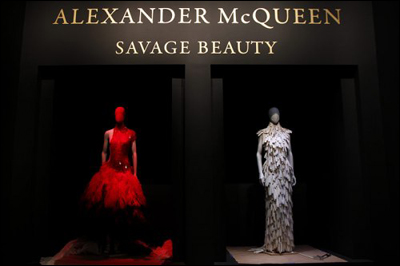
Savage Beauty foyer at The Metropolitan Museum of Art, 2011. (via)
The exhibit was set to close at the end of July, but has recently been extended until August 7th, and with good reason. Since it’s opening on May 4th, Savage Beauty has already been seen by some 500,000 visitors, and it shows no sign of slowing, evident by the endless queue bolstered up against The Storm and Judith as I left the museum. To accommodate the masses, the museum has added a special ‘Met Mondays with McQueen’ on evenings when the museum is typically closed. The viewing comes with a hefty price, fifty dollars (although a free audio guide is thrown in) and the sense that you can experience the show without rubbing elbows with everyone you came in with.
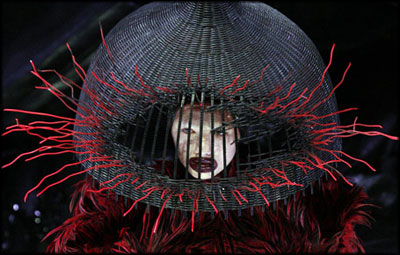
From McQueen’s Fall 2009 collection.
Predictably, the exhibit is popular, but the public insatiability is impressive. Rarely does a fashion designer get his own retrospective, and one so quickly by a curator’s standards after McQueen’s death has kept tongues wagging until it finally opened on the heels of the lavish Costume Institute Gala, which acted this year as an unofficial/official tribute thanks to the ensembles of Daphne Guinness, Hamish Bowles, Naomi Campbell and Sarah Jessica Parker.
But for those of us who have yet to strut up the plush red steps of the Met and attended the gala of all galas, one thing is evident from the first hall of the exhibit: this is the funeral that everyone is invited to. Two rows of headless wooden mannequins line up in their all-black ensembles of structured jackets, or tailored jumpsuits, or McQueen’s signature ‘bumster’ pants, creating an impression of startling clarity and finality; we are about to view the work of a dead man, and he is, despite the immortality of his own celebrity, never coming back.

Gallery view – ‘The Romantic Mind’. (via)
Beyond the first gallery, a room of tarnished mirrors reflects ensembles of billowing black silk, leather, jade beading, horse hair and tulle, all paying homage to the days of Edgar Allen Poe as the howling of wolves drifts through the gallery speakers. The term ‘sexy mourning garb’ doesn’t even begin to cut it. The next room treats various accessories and highlighted pieces as objects in a ‘cabinet of curiosities,’ Phillip Treacy hats and shoes resembling bondage gear taking their place under video screens which eerily flicker footage from past fashion shows such as What a Merry-Go-Round and It’s Only a Game.
Some of the pieces, such as the spine corset and headdresses bedecked with coins fit for a Berber bride, seem more like armor than straightforward fashion. There is something fiercely protective about McQueen’s designs, as if he is shielding his model from the cruelty of the outside world with the devices of his imagination that, at times, seem cruel.

Gallery View -‘Cabinet of Curiosities’ (via)
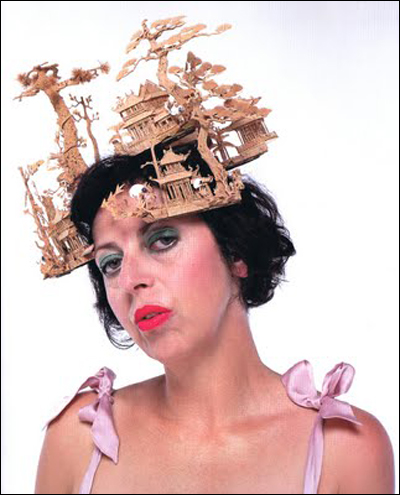
The incomparable Isabella Blow, modeling McQueen’s ‘Chinese Garden Hat’ from ‘It’s Only a Game,’ spring/summer 2005. (via)
It is only fitting that after someone dies, and especially when it is by suicide, that the hunt for visual clues to the individual’s sadness becomes sport. Clustered around his works, people whisper and twitter of his homosexuality, his fixation with bondage and the strangeness of his creations. Looking at each piece in its neat little box, the realization of how lonely McQueen’s pursuit for the sacred and profane must have been, and how devastating the loss of his closest confidantes –from his friend and mentor Isabella Blow in 2007 to his beloved mother in 2010– is palpable.
Projected 3D image of Kate Moss. Alexander McQueen Fall/Winter 2006 runway show.
Signifiers of McQueen’s internal struggles, and perhaps, his lifelong sense of alienation or “otherness”, are made manifest through his ingenious designs: external spine corsets, deconstructed armor, dresses of restrictive leather and horsehair, models retooled as masked and caped crusaders, or angelic, holographic ghosts. But it was his alienation that gave birth to the unreal, pushing the boundaries of the body, and romancing the human silhouette with Victorian cuts made both more modern and more feral through use of materials found only in the nature: pelts, feathers, scales, and horns.
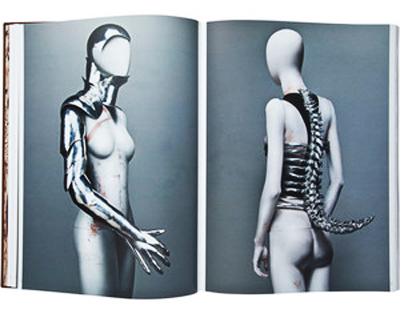
Layout from the Savage Beauty book. Left: Deconstructed aluminum armor, early aughts. Right: Spine Corset, Spring/Summer 1998 Aluminum and black leather.
Those practices, taking the ordinary or the unexpected and turning it into something extraordinary, are the marks of a true artist, a title which McQueen bore heavily. When you modeled for McQueen, you became a specimen worthy of a bell jar, fated to be pinned to a cork board or housed in formaldehyde. Perhaps McQueen himself felt constantly on display, wishing only to exist in that hothouse imagination where he was free to stab at lace with the horns of antlers, or lay beetle wings on a bodice. Memento Mori, those creations seem to say. Nothing this wonderful ever lasts.
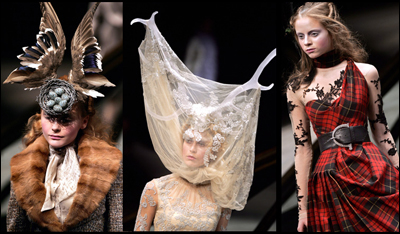
Unforgettable ensembles from ‘Widows of Culloden’ autumn/winter 2006-7. (via)
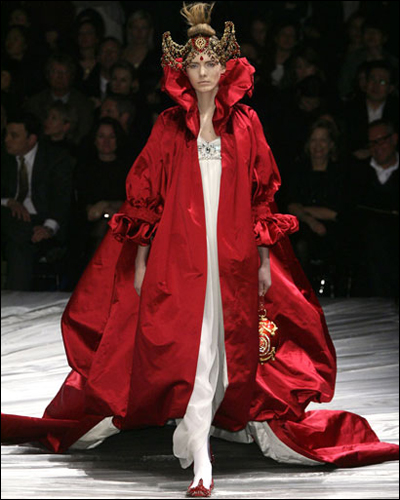
Ensemble from ‘The Girl Who Lived in a Tree,’ autumn/winter 2008. (via)
For those obsessed with the billowy, shimmery and tightly-laced, McQueen’s more patriotic collections, the Widows of Culloden and The Girl Who Lived in a Tree, speak to the true romantic mind with their silks of deep reds, high collared capes and playful use of ruffles. Each mannequin is a heroine in a fairy tale, ready to descend into the menacing snow-laced forest with a basket of apples hot on the trail of a wolf. These are the unabashedly pure McQueen collections, mixing the historical with the horrific and the beautiful, tethering on the brink between softness, with empire-waisted drapery, and harshness, with edgy jewels glimmering seductively on the throat.

“Oyster” Dress. Irere, spring/summer 2003. Ivory silk organza, georgette, and chiffon.
Widows was the collection that had McQueen accused of ‘a theatrical staging of cruelty,’ as the link between hot sex and terrible violence tends to bleed more profusely when in the hands of fashion. Yet these collections, presented together, are two sides of the same coin– the quixotic and dreamy combined with the bitter and realistic. Followed by McQueen’s fascinations with the Far East, sports, devastation, and evolution, Widows and Girl are central stones in a glimmering crown of accomplishment. With later collections, McQueen would continue to set the bar ever-higher for himself, challenging the idea of decay with gowns made from real roses, channeling the Hellenic sensual with padded hips, and envisioning a future inhabited by Amazons that tower above all else in shimmering booties and scaly bodysuits.
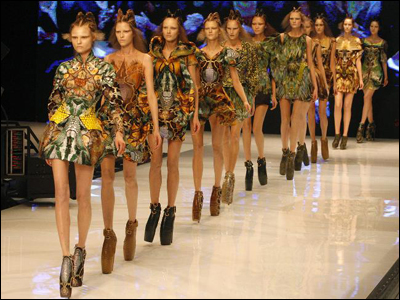
Spring 2010 runway (via)
McQueen courted death with his designs, beginning with his bleeding saints stitched to the backs of early jacket pieces, and continuing with the predatory nature of his collection It’s a Jungle Out There, as well as the skull-printed scarves that remain a perennial staple in the closets of fashionistas. His humor, although tongue-in-cheek, came from a wildly intelligent and dark place, and the arena of fashion was far from safe while he was alive. He was unafraid to offend and couldn’t help but rile, and in the process he put on one damn good show after another, revealing ensembles that, a century from now, will still scream ‘McQueen.’

Alexander McQueen (via)
“Iconic” is a word often tossed around with little clout, but in this case, it doesn’t seem large enough to house the images McQueen gave the world, or explain the choke hold he keeps on the hearts of his admirers from beyond the grave. Shoes are no longer shoes, but curlicued gold carriages; hats are made from butterflies and porcupine quills; dresses aren’t merely cloth but a second skin worn to guard oneself against melancholy and brace against the often overwhelming beauty and complexity that surrounds us. McQueen may no longer roam the earth that so tormented and inspired him, but his vision will continue to thrive under the watchful eyes of the house he left.
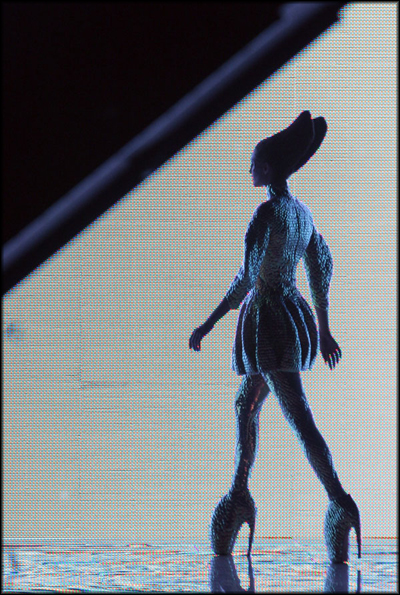
Alexander McQueen, Spring 2010 (via)
Alexander McQueen: Savage Beauty runs until August 7th , 2011 at The Metropolitan Museum of Art in New York City.
Editor’s note, July 30th, 2011: Certain bylines and captions have yet to be confirmed and formatted. They will be forthcoming.

July 30th, 2011 at 11:40 pm
Just bought my wife the catalog for this show. It’s amazing! If only we weren’t poor and on the west coast….
July 31st, 2011 at 9:16 am
He was a genius and despite what many people think about fashion as a minor art, he was a true artist
July 31st, 2011 at 9:37 am
Jane, I couldn’t agree more, and that is what made this show so spectacular. His work deserves to be in a museum, because each ensemble is truly a work of art, and the detail, care and thought that went into each of his collections was astounding to behold in person. Fashion non-believers, beware!
July 31st, 2011 at 9:29 pm
Great post, Sarah. I saw this exhibit a couple of months ago and felt so privileged to see these beautiful pieces of fashion and art, up close and personal.
July 31st, 2011 at 9:47 pm
Years ago, I was an unhappy teenage fashion model in Paris. I was lucky enough to be selected to do make-up testing for Givenchy’s upcoming show . Three days of having different combinations of scar wax, spirit gum, and various solvents painted and built up on my face by a load of talented british makeup artists. I caught a couple of glimpses of him, flitting about the atelier. I remembered him from having seen a picture of him with a union jack contact in one of his eyes. May have been Vogue. I don’t remember. I began to follow his work very closely after that. Anyhow, I digress.
Alexander McQueen makes me so SO angry.
Granted, the prolific body of work he completed in his brief period of creation is much more than most could hope to even fathom, but what makes me angriest is this: He took himself away from us.
Having been privy to the blackest depths of depression, I understand why he left…I just wish he had waited. The curtain always lifts, though it’s not often as high as the depressed would have it rise. Sometimes, the waiting becomes too much to bear.
His work was true art, and heartbreakingly beautiful.
I wish he would have stayed to make more.
August 1st, 2011 at 11:35 am
Most importantly this SATURDAY and SUNDAY the show will be open until MIDNIGHT.
August 1st, 2011 at 3:58 pm
Exactly, stepinrazor! Get thee to the show; I may make another appearance before the clock strikes 12!
August 1st, 2011 at 7:42 pm
Amazing piece of writing, Miss Hassan. Your piece opened my eyes to fashion as a true art form, and this guy seemed truly amazing! I’ll be eagerly awaiting his biography in book form or a movie based on his too short time in this world….
August 2nd, 2011 at 1:15 pm
I got to go to the exhibit only two weeks ago, and I have to say, it was beautiful. I can’t believe I was actually in the same room as all those works of art. The moment I caught a glimpse of some of the best pieces from his last collection, I choked up. The entire exhibit is beautiful and wonderfully curated. I only wish I could have seen a second time.
August 2nd, 2011 at 6:40 pm
oh wishing this come to AUSTRALIA PULEEEEase!!!
August 2nd, 2011 at 6:42 pm
FABULOUS article and tribute to an amazing icon who graced us with his glorious designs!!!!
August 4th, 2011 at 2:20 pm
I just saw this the other weekend in NYC and was so moved/blown away/happy, that I got choked up in the exhibit. Best of all for me was seeing the full outfit that inspired my McQueen obsession at age 15: The leather, molded top and hand-carved wooded prosthetic legs worn by a double-amputee model for one of his shows. 13 years ago I had cut that image from a magazine and pasted it in a scrapbook of inspiration, and there it was, the real thing, right before my eyes. It’s worth the flight to NYC to see this.
August 5th, 2011 at 9:38 am
Beautiful writing. Rare is the article worthy of him, and this is it. Well done.
August 6th, 2011 at 5:16 pm
[…] the incredible exhibit, Alexander McQueen’s Savage Beauty (fantastic overview from Coilhouse here,) which ends on August 7th, and D to see Anthony Caro on the Roof. We weren’t allowed to take […]